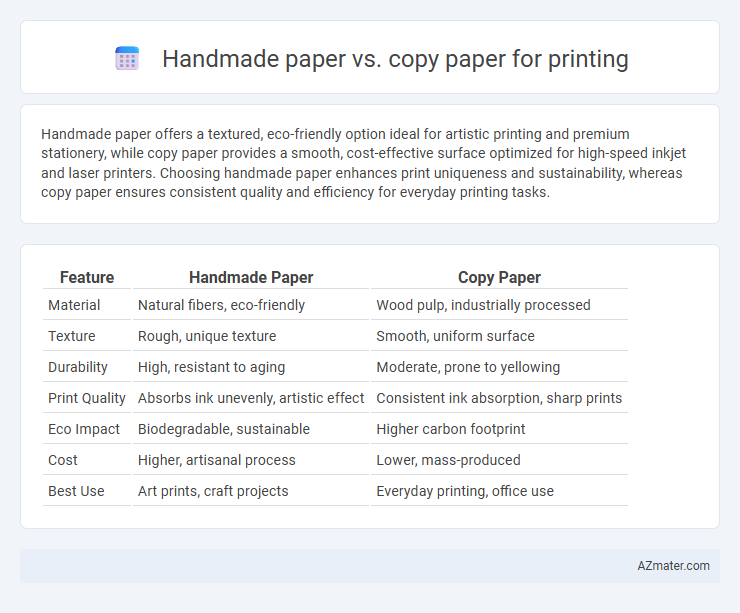Handmade paper offers a textured, eco-friendly option ideal for artistic printing and premium stationery, while copy paper provides a smooth, cost-effective surface optimized for high-speed inkjet and laser printers. Choosing handmade paper enhances print uniqueness and sustainability, whereas copy paper ensures consistent quality and efficiency for everyday printing tasks.
Table of Comparison
| Feature | Handmade Paper | Copy Paper |
|---|---|---|
| Material | Natural fibers, eco-friendly | Wood pulp, industrially processed |
| Texture | Rough, unique texture | Smooth, uniform surface |
| Durability | High, resistant to aging | Moderate, prone to yellowing |
| Print Quality | Absorbs ink unevenly, artistic effect | Consistent ink absorption, sharp prints |
| Eco Impact | Biodegradable, sustainable | Higher carbon footprint |
| Cost | Higher, artisanal process | Lower, mass-produced |
| Best Use | Art prints, craft projects | Everyday printing, office use |
Introduction: Understanding Handmade and Copy Paper
Handmade paper, produced through traditional methods involving natural fibers and manual processes, offers unique textures and durability, making it ideal for artistic and specialty printing applications. Copy paper, manufactured through industrial processes using wood pulp, provides consistent quality, smoothness, and cost-effectiveness suited for everyday printing needs. Understanding these fundamental differences helps in selecting the appropriate paper type for desired print quality and project requirements.
Composition and Materials Used
Handmade paper is crafted from natural fibers such as cotton, hemp, or mulberry bark, resulting in a textured surface that absorbs ink differently than copy paper. Copy paper typically consists of wood pulp treated with chemical additives like chlorine and fillers to ensure smoothness and uniformity, optimizing it for high-speed printing. The organic composition of handmade paper offers durability and unique aesthetics, while copy paper's synthetic additives enhance compatibility with standard printers and copiers.
Manufacturing Process Differences
Handmade paper is crafted using traditional methods that involve soaking natural fibers, usually cotton or mulberry, then spreading the pulp manually onto a screen, followed by pressing and drying, resulting in a textured, fibrous surface ideal for artistic prints and high-end stationery. In contrast, copy paper for printing is produced through an industrial process where wood pulp undergoes chemical or mechanical treatments, followed by large-scale bleaching, pressing, and calendaring to create a smooth, uniform sheet optimized for high-speed inkjet and laser printing. The manufacturing distinctions impact durability, surface finish, and ink absorption, with handmade paper offering unique aesthetics and copy paper providing consistency and efficiency for everyday printing needs.
Texture and Surface Quality
Handmade paper features a unique, fibrous texture with an uneven surface that adds character but may cause ink absorption inconsistencies during printing. Copy paper offers a smooth, uniform surface designed for optimal ink adherence and sharp image reproduction, ensuring consistent print quality. The textured surface of handmade paper is ideal for artistic prints, while copy paper suits high-volume, precise document printing.
Print Compatibility and Performance
Handmade paper offers a unique texture and absorbency that can enhance print quality for artistic projects but may cause uneven ink distribution and slower drying times in standard printing devices. Copy paper, engineered for high-speed inkjet and laser printers, ensures consistent ink adhesion, fast drying, and sharp text reproduction, making it ideal for everyday printing tasks. Print compatibility favors copy paper for reliability and efficiency, while handmade paper suits specialized prints requiring a distinctive tactile finish.
Aesthetic Appeal and Uniqueness
Handmade paper offers a distinctive texture and natural fiber variations that enhance the aesthetic appeal of printed materials, providing a tactile and visually rich experience unmatched by standard copy paper. The irregularities and organic patterns in handmade paper create a sense of uniqueness, making each print feel exclusive and artisanal. In contrast, copy paper's uniformity and smooth surface prioritize functionality over artistic expression, resulting in a consistent but less visually engaging print output.
Environmental Impact and Sustainability
Handmade paper, produced from natural fibers with minimal chemical processing, significantly reduces environmental impact compared to copy paper, which is often made from wood pulp requiring extensive bleaching and energy-intensive manufacturing. The biodegradability and recyclability of handmade paper enhance its sustainability, promoting the conservation of forest resources and lowering carbon emissions throughout its lifecycle. Copy paper's widespread use contributes to deforestation and pollution, whereas handmade paper supports eco-friendly practices by utilizing recycled or agricultural waste fibers.
Cost Comparison and Accessibility
Handmade paper typically costs significantly more than copy paper due to its labor-intensive production and limited availability, making it less accessible for everyday printing needs. Copy paper is mass-produced, widely available in various grades, and priced affordably for high-volume use in offices and schools. Choosing copy paper over handmade paper ensures consistent print quality at a fraction of the cost, benefiting budget-conscious users and large-scale printing.
Typical Uses and Best Applications
Handmade paper, known for its textured surface and unique fibers, excels in artistic printing projects, invitations, and specialty stationery where aesthetic appeal and tactile quality are paramount. Copy paper, characterized by its smooth finish and uniform consistency, is ideal for high-volume printing tasks, everyday document reproduction, and office use requiring crisp text and efficient ink absorption. Selecting between handmade and copy paper depends on the desired print quality, project significance, and visual impact.
Choosing the Right Paper for Your Printing Needs
Handmade paper offers a unique texture and durability ideal for artistic printing and special projects requiring a premium touch, while copy paper provides a smooth, consistent surface optimized for everyday printing efficiency and cost-effectiveness. Selecting the right paper depends on the printing purpose; choose handmade paper for invitations, certificates, or high-end marketing materials to enhance visual impact and longevity. For bulk printing tasks, drafts, and standard documents, copy paper ensures fast printing speeds with minimal printer wear and sharp text clarity.

Infographic: Handmade paper vs Copy paper for Printing
 azmater.com
azmater.com